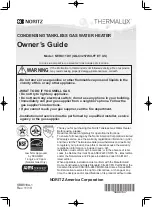
30
3.15. Vent Terminal Location
1. Condensate can freeze on the vent cap. Frozen
condensate on the vent cap can result in a blocked
flue condition.
A
A
WARNING:
All venting types must be of the same
material or product throughout the entire exhaust
installation to ensure proper securing and sealing.
2. Give special attention to the location of the vent
termination to avoid possibility of property damage
or personal injury.
3. Gases may form a white vapor plume in winter.
The plume could obstruct a window view if the
termination is installed near windows.
4. Prevailing winds, in combination with below-freezing
temperatures, can cause freezing of condensate
and water/ice build-up on buildings, plants or roofs.
5. The bottom of the vent terminal and the air intake
shall be located at least 12" (305 mm) above grade,
including normal snow line.
6. Un-insulated single-wall Category IV metal vent
pipe shall not be used outdoors in cold climates for
venting gas-fired equipment.
7. Through-the-wall vents for Category IV appliances
shall not terminate over public walkways or over
an area where condensate or vapor could create
a nuisance or hazard or could be detrimental to
the operation of regulators, relief valves, or other
equipment.
8. Locate and guard vent termination to prevent
accidental contact by people or pets.
9. DO NOT terminate vent in window well, stairwell,
alcove, courtyard or other recessed area.
10. DO NOT terminate above any door, window, or
gravity air intake. Condensate can freeze, causing
ice formations.
11. Locate or guard vent to prevent condensate from
damaging exterior finishes. Use a rust-resistant
sheet metal backing plate against brick or masonry
surfaces.
12. DO NOT extend exposed vent pipe outside of
building beyond the minimum distance required for
the vent termination. Condensate could freeze and
block vent pipe.
3.15.1. U.S. Installations
Refer to the latest edition of the National Fuel Gas Code.
Vent termination requirements are as follows:
1.
Vent must terminate at least 4' (1.2 m) below or 4'
(1.2 m) horizontally from, window or gravity air inlet
to the building.
2. The vent must not terminate above public walkways
due to slip hazard from frozen condensate.
3.
Terminate vent at least 3' (915 mm) above any forced
air inlet located within 10' (3 m).
4.
Vent must terminate at least 4' (1.2 m) horizontally,
and in no case above or below unless 4' (1.2 m)
horizontal distance is maintained, from electric
meters, gas meters, regulators, and relief equipment.
5.
Terminate vent at least 6' (1.8 m) away from adjacent
walls.
6.
DO NOT terminate vent closer than 5' (1.5 m) below
roof overhang.
7. The D-15 sidewall
vent terminal requires a 12" (305
mm) vent terminal clearance from the wall.
VENT CAPS STACKED VERTICALLY
FLUE GASES MOVING IN PARALLEL
VENT CAPS ALL AT SAME ELEVATION
FLUE GASES MOVING TOWARD EACH OTHER
VENT CAPS AT STAGGERED ELEVATIONS
FLUE GASES MOVING TOWARD EACH OTHER
1" (25 mm)
MIN. (TYP)
2" (50 mm) MIN. (TYP)
DISCHARGE
4' (1.2 m)
MIN. (TYP)
DISCHARGE
4' (1.2 m)
MIN. (TYP)
1" (25 mm)
MIN. (TYP)
Figure 34.
Multiple Sidewall Vent Cap Configurations
8.
Terminate vent at least 1' (305 mm) above grade,
including normal snow line.
9.
Multiple direct-vent installations require a 4' (1.2 m)
clearance between the ends of vent caps located on
the same horizontal plane.
A
A
WARNING:
The Commonwealth of Massachusetts
requires that sidewall vented heaters, installed in every
dwelling, building or structure used in whole or in part for
residential purposes, be installed using special provisions
as outlined on page 58 of this manual.
Содержание Xtherm 1005A
Страница 62: ...62...
Страница 63: ...63...
Страница 64: ...www raypak com Raypak Inc 2151 Eastman Avenue Oxnard CA 93030 805 278 5300 Fax 805 278 5468 Litho in U S A...
















































